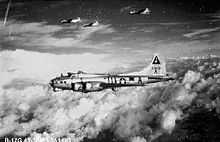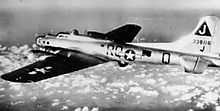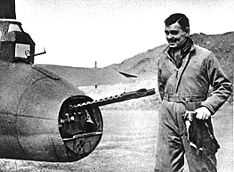351st Operations Group
| 351st Operations Group | |
|---|---|
 World War II 351st Bombardment Group Emblem | |
| Active | 1942–1945; 1947–1949; 1991–1995 |
| Country | United States |
| Branch | United States Air Force |
| Engagements | World War II |



|
|
The 351st Operations Group (351 OG) is an inactive unit of the United States Air Force. Its last assignment was with to the 351st Missile Wing, being stationed at Whiteman Air Force Base, Missouri. It was inactivated on 31 July 1995.
During World War II, its predecessor unit, the 351st Bombardment Group was a VIII Bomber Command B-17 Flying Fortress unit in England. Assigned to RAF Polebrook in early 1943, the group's 504th Bomb Squadron made 54 consecutive missions on June 1943 to January 1944 without losses. Two members of the 351st Bombardment Group, Lt. Walter E. Truemper and S/Sgt. Archibald Mathies, were posthumously awarded the Medal of Honor on a mission to Leipzig, Germany, 20 February 1944.
The 351st was the unit to which Captain Clark Gable was assigned.[1] Gable flew five combat missions, including one to Germany, as an observer-gunner in B-17 Flying Fortresses between 4 May and 23 September 1943, earning the Air Medal and the Distinguished Flying Cross for his efforts.
History
- For additional history and lineage, see 351st Missile Wing
World War II
Activated 1 October 1942 at Salt Lake City AB, Utah. The group established at Geiger Field in Washington in November 1942 where the Group was assembled for initial training, and the Second phase of training was conducted at Biggs Field, Texas, between December 1942 and March 1943. The unit then moved to Pueblo AAB, Colorado for preparation for overseas movement. the ground unit left Pueblo for New York on 12 April 1943. the aircraft began movement on 1 April 1943. In April–May 1943, the unit moved to RAF Polebrook England to serve in combat with Eighth Air Force. It was assigned to the 94th Combat Wing, also at Polebrook. The group tail code was a "Triangle J".
The 351st's first completed combat mission took place on 14 May 1943, when 18 B-17's targeted a German Luftwaffe airfield at Kortrijk, Belgium. As the war progressed, the 351st operated primarily against strategic objectives in Germany, striking such targets as ball-bearing plants at Schweinfurt, communications at Mayen, marshalling yards at Koblenz, a locomotive and tank factory at Hanover, industries at Berlin, bridges at Cologne, an armaments factory at Mannheim, and oil refineries at Hamburg.
The group also struck harbor facilities, submarine installations, airfields, V-weapon sites, and power plants in France, Belgium, the Netherlands, and Norway.
The 351st Received a Distinguished Unit Citation (DUC) for performance on 9 October 1943, when an aircraft factory in Germany was accurately bombed in spite of heavy flak and pressing enemy interceptors. It received another DUC for its part in the successful attack of 11 January 1944, on aircraft factories in central Germany. The group participated in the intensive air campaign against the German aircraft industry during "Big Week", 20–25 February 1944.
In addition to its strategic missions, the group often operated in support of ground forces and attacked interdictory targets. Bombed in support of the Battle of Normandy in June 1944 and the Saint-Lô breakthrough in July. The group hit enemy positions to cover the airborne attack on the Netherlands in September 1944 and subsequently struck front-line positions, communications, and airfields to help stop the German counteroffensive in the Battle of the Bulge, December 1944 – January 1945. The 351st later flew missions in support of Operation Varsity, the airborne assault across the Rhine in March 1945.
The 351st conducted routine 8th Air Force missions from RAF Polebrook until the end of the war. The unit completed 311 combat missions from Polebrook. The 351st lost 175 B-17's and their crews. The gunners in the Group fired off 2,776,028 rounds of ammunition and were credited with destroying 303 enemy aircraft.
Redeployed to the US in May and June 1945. the first aircraft left on 21 May 1945. the ground unit sailed for the US on 25 June 1945 aboard the Queen Elizabeth. Docked the US in July 1945, but the group inactivated on 28 August 1945.
During the early years of the Cold War, the 351st Bombardment Group (Very Heavy) was part of the Air Force Reserve between 1947 and 1949.
Strategic Missiles
Activated as the 351st Operations Group on 1 September 1991 under the "Objective Wing" concept adapted by the Air Force. The ICBM squadrons of the renamed 351st Missile Wing were reassigned to the newly established group, along with the lineage, honors and history of the 351st Bombardment Group.
On 28 September 1991, in response to President Bush's directive to stand down the Minuteman II, personnel of the 351 OG began to dissipate launch codes and pin safety control switches at launch control centers.
On 1 June 1992, the 351 OG was relieved of its emergency war order mission and its primary focus was deactivation of the Minuteman II weapon system. This day also marked the end of SAC and the beginning of Air Combat Command (ACC).
On 1 July 1993 its parent unit, the 351 MW changed hands from ACC to Air Force Space Command along with all other ICBM wings. The 508th, 509th and 510th Missile Squadrons were inactivated along with the 351st Operations Group on 31 July 1995.
Lineage
- Constituted as 351st Bombardment Group (Heavy) on 25 September 1942
- Activated on 1 October 1942
- Inactivated on 28 August 1945.
- Redesignated 351st Bombardment Group (Very Heavy)
- Activated on 9 April 1947
- Inactivated on 27 June 1949.
- Redesignated 351st Operations Group and activated on 1 September 1991
- Inactivated on 31 July 1995
Assignments
- II Bomber Command, 1 October 1942 – 12 April 1943
- 1st Bombardment Wing, May 1943
- Attached to: 101st Provisional Combat Bombardment Wing, May 1943 – 13 September 1943
- 94th Combat Bombardment Wing, 1 November 1943 – 23 June 1945
- Army Service Forces (for inactivation), July – 28 August 1945
- Tenth Air Force, 9 April 1947 – 27 June 1949
- 351st Missile Wing, 1 September 1991 – 31 July 1995
Components
- 508th Bombardment (later Missile) Squadron (YB), 1 October 1942 – 28 August 1945; 15 October 1947 – 27 June 1949; 1 September 1991 – 31 July 1995
- 509th Bombardment (later Missile) Squadron (RQ), 1 October 1942 – 28 August 1945; 9 May 1947 – 3 May 1948; 1 September 1991 – 31 July 1995
- 510th Bombardment (later Missile) Squadron (TU), 1 October 1942 – 28 August 1945; 15 September 1947 – 3 May 1948; 1 September 1991 – 31 July 1995
- 511th Bombardment Squadron (DS), 1 October 1942 – 28 August 1945; 15 October 1947 – 27 June 1949
Stations
|
|
Aircraft and missiles
- B-17 Flying Fortress, 1942–1995
- B-29 Superfortress, 1947–1949
- LGM-30F Minuteman II, 1991–1995
References
- ↑ A film of the unit activities in the war, Combat America, featured Gable and was narrated by him. See: Combat America at the American Film Institute Catalog.
![]() This article incorporates public domain material from websites or documents of the Air Force Historical Research Agency.
This article incorporates public domain material from websites or documents of the Air Force Historical Research Agency.
- Freeman, Roger A. (1978) Airfields of the Eighth: Then and Now. After the Battle ISBN 0-900913-09-6
- Freeman, Roger A. (1991) The Mighty Eighth: The Colour Record. Cassell & Co. ISBN 0-304-35708-1
- Maurer, Maurer (1983). Air Force Combat Units of World War II. Maxwell AFB, Alabama: Office of Air Force History. ISBN 0-89201-092-4.
External links
- 351 BG(H), US 8th Air Force, W.W.II
- 351st Bombardment Group at Polebrook
- History of the 351st
- Eighth Air Force Historical Society 351st Bombardment Group
- History of the 315st Bomb Group Heavy
| ||||||||||||||||||||||||||||||||||||||||||||||||||||||||||||||||||||||||||||||||||||||||||||
| |||||||||||||||||||||||||||
| |||||||||||||||||||||||||||||||||||||||||||||||||||||
| |||||||||||||||||||||||||||||||||



